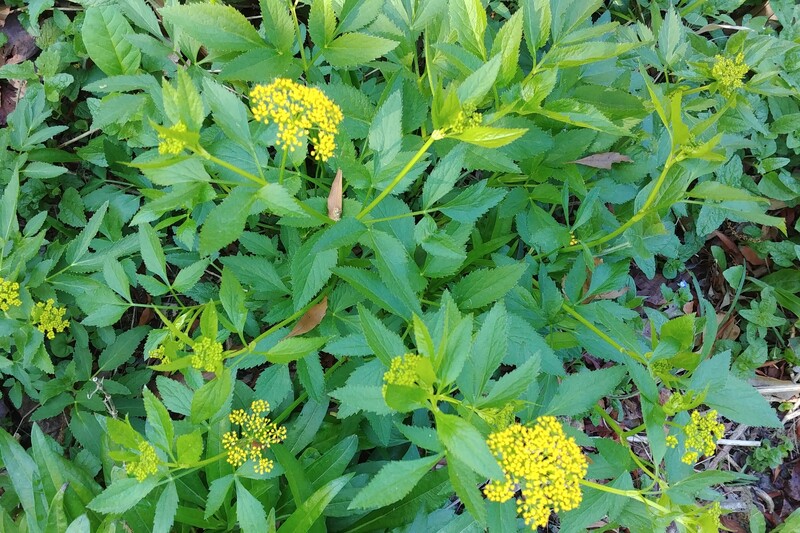Piedmont Bottomlands, Floodplains, and Riparian Zones
|
This natural community occurs along rivers and streams. It consists of:
1) Bottomland and Floodplain (Alluvial) Forest: flat, low-lying areas beyond the stream channel that flood at least occasionally. Sediments from the floodwaters (called "alluvium") settle in these areas. Often called "alluvial forests", they are close to the water table. Seepage wetlands are often embedded within them. Plants have special adaptations to cope with soggy, low oxygen conditions and sedimentation. The topography, shaped by floods, varies greatly, with hummocks that are nearly mesic, and depressional areas that are often saturated. Soils are often nutrient-rich because of the influx of new sediments from flooding. 2) Riparian zone - the land along the river channel. This zone is flooded often. Some stream sides are rocky, with plants rooted among the boulders, while others consist of sediments. Plant are adapted to sunnier conditions and can withstand the force of floodwaters. Rivers meander in S-shaped patterns. Indicator species: Box elder, river birch, green ash, sycamore, overcup oak, black willow |
Landscapes
What's special: The high nutrient levels and moisture foster rich, lush vegetation layers, with many food and shelter resources. This variety of habitats supports a diversity of amphibians, birds and stream-side mammals. These communities keep water resources clean by stabilizing stream banks. They also buffer areas further from the stream from flooding
Related communities: High areas in the bottomlands, and those farthest from the flood zone grade into Mesic Forests. Seepage Wetlands are often embedded within the bottomlands, and grade into Wet Meadows. |
|
Plants
Click on a plant name to see images and more information about each plant. Trees Box elder Acer negundo Red maple Acer rubrum var. triloba River birch Betula nigra Bitternut hickory Carya cordiformis Shagbark hickory Carya ovalis Sugarberry Celtis laevigata Green ash Fraxinus pennsylvanica Black walnut Juglans nigra Sweetgum Liquidambar styraciflua Tulip-tree Liriodendron tulipifera Sycamore Platanus occidentalis Overcup oak Quercus lyrata Swamp chestnut oak Quercus michauxii Water oak Quercus nigra Cherrybark oak Quercus pagoda Willow oak Quercus phellos Shumard oak Quercus shumardii Winged elm Ulmus alata Slippery elm Ulmus rubra Understory (to medium size) trees Box elder Acer negundo Red maple Acer rubrum Devil's walking stick Aralia spinosa Musclewood/American hornbeam Carpinus caroliniana Flowering dogwood Cornus florida Littlehip hawthorn Crataegus spathulata (esp. basic) Persimmon (American) Diospyros virginiana Carolina buckthorn Frangula caroliniana (esp. over calcareous and mafic rock) American holly Ilex opaca Sweetbay Magnolia virginiana Red mulberry Morus rubra Black willow Salix nigra Ironwood/ Hophornbeam Ostrya virginiana (esp. basic) Shrubs Painted buckeye Aesculus sylvatica (nutrient-rich forests) Tag alder Alnus serrulata Chokeberry (red) Aronia arbutifolia Giant cane Arundinaria gigantea Pawpaw Asimina triloba (nutrient-rich forests) Beautyberry Callicarpa americana Sweet shrub Calycanthus floridus Buttonbush Cephalanthus occidentalis Silky/Swamp dogwood Cornus amomum Hearts-a-bustin' Euonymus americanus Witch-alder Fothergilla major Witch-hazel Hamamelis virginiana Smooth hydrangea Hydrangea arborescens Oakleaf hydrangea Hydrangea quercifolia Possumhaw Ilex decidua Winterberry Ilex verticillata Virginia sweetspire Itea virginica Mountain laurel Kalmia latifolia Doghobble Leucothoe fontanesiana Spicebush Lindera benzoin Piedmont azalea Rhododendron canescens (acidic) Swamp azalea Rhododendron viscosum Elderberry Sambucus canadensis American snowbell/storax Styrax americana Horse sugar Symplocus tinctoria Mayberry/Elliott's blueberry Vaccinium elliottii Mapleleaf viburnum Viburnum acerifolium Arrowwood Viburnum dentatum Blackhaw/Nannyberry Viburnum prunifolium Yellowroot Xanthorhiza simplicissima Vines Ground nut Apios americana Crossvine Bignonia capreolat Trumpet vine Campsis radicans Virgin's bower Clematis virginiana Climbing hydrangea Decumaria barbara Carolina jessamine Gelsemium sempervirens Wild potato vine Ipomoea pandurata Carolina spinypod Matelea carolinensis (nutrient rich soils/rock) Climbing hempweed Mikania scandens Virginia creeper Parthenocissus quinquefolia Greenbrier (whiteleaf/sawbrier) Smilax glauca Poison ivy Toxicodendron radicans Muscadine Vitis rotundifolia Ground Layer Forbs Ragweed Ambrosia trifida Eastern bluestar Amsonia tabernaemontana Jack-in-the-pulpit Arisaema triphyllum False nettle Boehmeria cylindrica Fairywand/Devil's bit Chamaelirium luteum Turtlehead (white) Chelone glabra Mist flower Conoclinium coelistinum Trout lily Erythronium umbilicatum Hollow-stem Joe-Pye-weed Eutrochium fistulatum Avens Geum canadense Shuttleworth's ginger Hexastylis shuttleworthii Swamp (eastern) rose mallow Hibiscus moscheutos Jewelweed (orange) Impatiens capensis Cardinal flower Lobelia cardinalis Great blue lobelia Lobelia siphilitica Seedbox Ludwigia alternifolia Fringed loosestrife Lysimachia ciliata Monkey flower Mimulus ringens Partridgeberry Mitchella repens Kidney-leaved grass-of-Parnassus Parnassia asarifolia Arrow arum Peltandra virginica May-apple Podophyllum peltatum Calico aster Symphyotrichum laterifolum Cutleaf coneflower Rudbeckia laciniata Duck potato/Broadleaf arrowhead Sagittaria latifolia Lizard's-tail Saururus cernuus Skullcap Scutellaria integrifolia Foamflower Tiarella wherryi Tassel-rue Trautvetteria caroliniensis Sweet Betsy/Toadshade trillium Trillium cuneatum Wingstem (common) Verbesina alternifolia Ironweed (common) Vernonia gigantea Blue marsh violet Viola cucullata Atamasco lily Zephyranthes atamasco Golden Alexander Zizia aurea Ferns Rattlesnake fern Botrypus virginianus Netted chain fern Lorinseria areolata Royal fern Osmunda spectabilis Cinnamon fern Osmundastrum cinnamomeum New York fern Parathelypteris novaboracensis Grasses, Sedges, and Rushes Shallow sedge Carex lurida River oats Chasmanthium latifolium Longleaf spikegrass Chasmanthium sessiliflorum Virginia wild rye grass Elymus virginicus Common rush Juncus effusis Nimblewill/Nimbleweed Muhlenbergia schreberi Beaked panic grass Panicum anceps/Coleataenia anceps Woolgrass bulrush Scirpus cyperinus Gamma grass Tripsacum dactyloides |
Representative Trees in order by scientific name
Representative shrubs in order by scientific name.
Representative vines. in order by scientific name.
Representative wildflowers in order by scientific name,
Representative Ferns, in order by scientific name
Representative Graminoids, in order by scientific name
Birds |



















































































